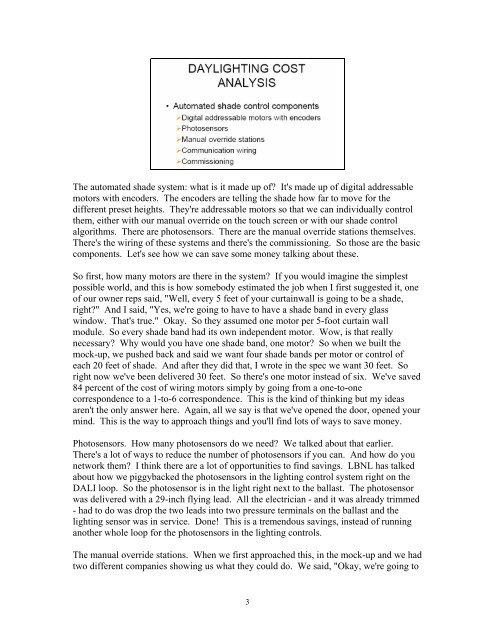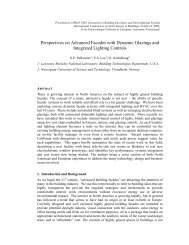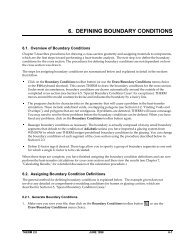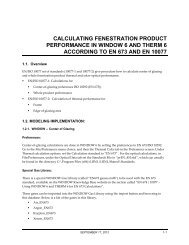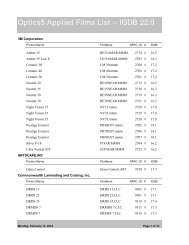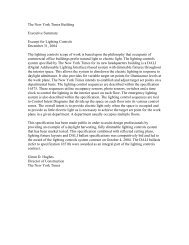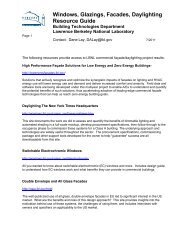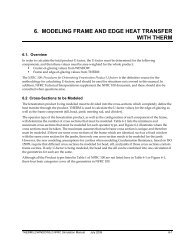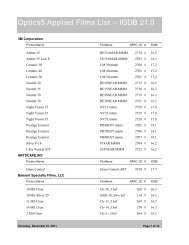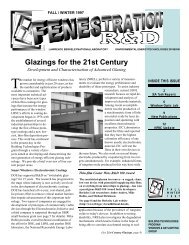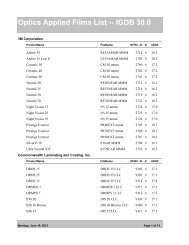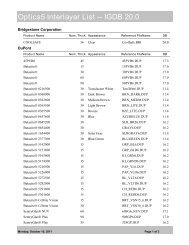imagine in <strong>to</strong>day's world with a myopic view when we look at what energy costs are<strong>to</strong>day <strong>and</strong> we say, "What's the return on investment? Is it two years or five years or sevenyears?" You have <strong>to</strong> think about what's happening <strong>to</strong> the cost of energy as well. Justthink about the gas that you're putting in your cars if you own them. I haven't owned onefor seven years, so I haven't felt that pinch, but I'm sure plenty have.Lighting energy savings. With just the daylighting controls alone, with LawrenceBerkeley National Lab's help, we proved that we could save 30 percent - almost withouteven trying based on the type of window wall we have, the clarity of the glass, the heigh<strong>to</strong>f the ceiling, all the things I've <strong>to</strong>ld you about - that was just pretty much h<strong>and</strong>ed <strong>to</strong> us: a30 percent savings, as long as the system works properly. And if you push it a little bit,you can get it <strong>to</strong> somewhere around 50 percent. We also have the target setpoint. Insteadof 50 footc<strong>and</strong>les, which is the design output level of our lighting system, what if we godown <strong>to</strong> 40 footc<strong>and</strong>les, what if we go down <strong>to</strong> 30 footc<strong>and</strong>les? Well, now we're starting<strong>to</strong> save 20 percent, 40 percent that way. All spaces aren't going <strong>to</strong> be down at 30footc<strong>and</strong>les, but some will. So we've got a mix, somewhere between 30 <strong>and</strong> 40footc<strong>and</strong>les is what I think is where we're going <strong>to</strong> l<strong>and</strong> for the vast majority of our space<strong>and</strong> we'll have some down at 20 footc<strong>and</strong>les, we'll have a few at 50 footc<strong>and</strong>les, but we'regoing <strong>to</strong> end up somewhere in the 30 <strong>to</strong> 40 footc<strong>and</strong>les range. So that's a significantsavings over the st<strong>and</strong>ard lighting set up in a building. We looked at that <strong>and</strong> we said,"Well, using last year's energy costs here in New York City, we could save $15,000 ayear based on reducing our lighting energy with the combination of daylighting <strong>and</strong>reduction in the target set points. And I think that's conservative. I'm not going <strong>to</strong> giveyou the materials <strong>and</strong> installation cost per square foot, so don't even bother <strong>to</strong> ask me.Now because we are using less lighting, we're using less air conditioning <strong>and</strong> a quicktranslation or correlation between those kilowatt-hours <strong>and</strong> BTUs tells me that we aresaving another $5,000 on air conditioning costs because our lighting levels are that muchlower than would have been otherwise. So we're looking at $20,000 a floor, our floorsare 25,000 square feet, a pretty modest size.We also, <strong>and</strong> this is where it gets qualitative, believe that these systems enhance the waywe work. They make us better at what we do by living in a world full of natural light <strong>and</strong>less electric light <strong>and</strong> a dynamic workspace that's changing, that you allow your body <strong>to</strong>feel the changes of Mother Nature. This leads <strong>to</strong>, we believe, productivity improvements,but we don't know how <strong>to</strong> measure that. I wish I did. We ran around the country, wetalked <strong>to</strong> a number of people <strong>and</strong> nobody convinced us that they really know how <strong>to</strong>measure productivity yet. So that's one of those great open <strong>to</strong>pics for some reallysignificant research in this generation of people coming up now. There are a lot ofpeople going <strong>to</strong> school, grad school, going <strong>to</strong> college right now that are interested in thesetypes of systems <strong>and</strong> care about it <strong>and</strong> believe in it <strong>and</strong> maybe they will be the ones thatcan get this done now.2
The au<strong>to</strong>mated shade system: what is it made up of? It's made up of digital addressablemo<strong>to</strong>rs with encoders. The encoders are telling the shade how far <strong>to</strong> move for thedifferent preset heights. They're addressable mo<strong>to</strong>rs so that we can individually controlthem, either with our manual override on the <strong>to</strong>uch screen or with our shade controlalgorithms. There are pho<strong>to</strong>sensors. There are the manual override stations themselves.There's the wiring of these systems <strong>and</strong> there's the commissioning. So those are the basiccomponents. Let's see how we can save some money talking about these.So first, how many mo<strong>to</strong>rs are there in the system? If you would imagine the simplestpossible world, <strong>and</strong> this is how somebody estimated the job when I first suggested it, oneof our owner reps said, "Well, every 5 feet of your curtainwall is going <strong>to</strong> be a shade,right?" And I said, "Yes, we're going <strong>to</strong> have <strong>to</strong> have a shade b<strong>and</strong> in every glasswindow. That's true." Okay. So they assumed one mo<strong>to</strong>r per 5-foot curtain wallmodule. So every shade b<strong>and</strong> had its own independent mo<strong>to</strong>r. Wow, is that reallynecessary? Why would you have one shade b<strong>and</strong>, one mo<strong>to</strong>r? So when we built themock-up, we pushed back <strong>and</strong> said we want four shade b<strong>and</strong>s per mo<strong>to</strong>r or control ofeach 20 feet of shade. And after they did that, I wrote in the spec we want 30 feet. Soright now we've been delivered 30 feet. So there's one mo<strong>to</strong>r instead of six. We've saved84 percent of the cost of wiring mo<strong>to</strong>rs simply by going <strong>from</strong> a one-<strong>to</strong>-onecorrespondence <strong>to</strong> a 1-<strong>to</strong>-6 correspondence. This is the kind of thinking but my ideasaren't the only answer here. Again, all we say is that we've opened the door, opened yourmind. This is the way <strong>to</strong> approach things <strong>and</strong> you'll find lots of ways <strong>to</strong> save money.Pho<strong>to</strong>sensors. How many pho<strong>to</strong>sensors do we need? We talked about that earlier.There's a lot of ways <strong>to</strong> reduce the number of pho<strong>to</strong>sensors if you can. And how do younetwork them? I think there are a lot of opportunities <strong>to</strong> find savings. LBNL has talkedabout how we piggybacked the pho<strong>to</strong>sensors in the lighting control system right on theDALI loop. So the pho<strong>to</strong>sensor is in the light right next <strong>to</strong> the ballast. The pho<strong>to</strong>sensorwas delivered with a 29-inch flying lead. All the electrician - <strong>and</strong> it was already trimmed- had <strong>to</strong> do was drop the two leads in<strong>to</strong> two pressure terminals on the ballast <strong>and</strong> thelighting sensor was in service. Done! This is a tremendous savings, instead of runninganother whole loop for the pho<strong>to</strong>sensors in the lighting controls.The manual override stations. When we first approached this, in the mock-up <strong>and</strong> we hadtwo different companies showing us what they could do. We said, "Okay, we're going <strong>to</strong>3


